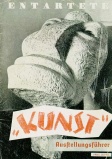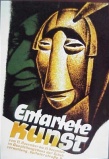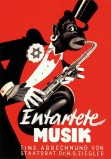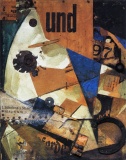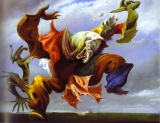Difference between revisions of "Degenerate art"
(Created page with "* http://www.vam.ac.uk/content/articles/e/entartete-kunst/") |
|||
| (4 intermediate revisions by 2 users not shown) | |||
| Line 1: | Line 1: | ||
| − | * | + | ''''Entartete Kunst'''' (or 'Degenerate Art') was a derogatory term adopted by the Nazi regime in Germany, to describe art that was banned on the grounds that it was un-German, Jewish, or Communist in nature, and those identified as degenerate artists were subjected to sanctions. Avant-garde German artists were branded both enemies of the state and a threat to German culture and national mental health. |
| + | |||
| + | An exhibition entitled ''Entartete Kunst'' opened in Munich in 1937 displaying works deemed to be ‘an insult to German feeling’ and went on to tour the country. The 'degenerate' verdict applied to virtually all German modernist art, including over 100 artists, but works by internationally renowned artists such as Picasso were also seized. | ||
| + | |||
| + | While modern styles of art were prohibited, the Nazis promoted paintings and sculptures that were traditional in manner and that exalted the "blood and soil" values of racial purity, militarism, and obedience. Similar restrictions were placed upon music, which was expected to be tonal and free of any jazz influences; disapproved music was termed degenerate music. Films and plays were also censored. | ||
| + | |||
| + | A large amount of "degenerate art" by [[Picasso]], [[Dalí]], [[Ernst]], [[Klee]], [[Léger]] and [[Miró]] was destroyed in a bonfire on the night of 27 July 1942 in Paris. | ||
| + | |||
| + | <gallery> | ||
| + | File:Entartete_Kunst_catalogue_Otto_Freundlich.jpg|Catalogue cover | ||
| + | File:Entartete_Kunst_poster.jpg|Exhibition poster, 1937 | ||
| + | File:Entartete_musik_poster.jpg | ||
| + | File:Kurt_Schwitters_DasUndbild_1919.jpg|Kurt Schwitters, ''Das Unbild'', 1919 | ||
| + | File:Max_Ernst_L'Ange_du_Foyeur_1937.jpg|Max Ernst, ''L'Ange du foyeur'', 1937 | ||
| + | </gallery> | ||
| + | |||
| + | ; Documents | ||
| + | * ''[[Media:Entartete_Kunst_1_1941_2014.pdf|"Entartete" Kunst, 1: Aachen - Görlitz]]'', Berlin: Reichsministerium für Volksaufklärung und Propaganda, c.1941/1942, 233 pp; repr., London: Victoria and Albert Museum, 2014. [https://www.vam.ac.uk/articles/explore-entartete-kunst-the-nazis-inventory-of-degenerate-art] | ||
| + | * ''[[Media:Entartete_Kunst_1_1941_2014.pdf|"Entartete" Kunst, 2: Göttingen - Zwickau]]'', Berlin: Reichsministerium für Volksaufklärung und Propaganda, c.1941/1942, 249 pp; repr., London: Victoria and Albert Museum, 2014. [https://www.vam.ac.uk/articles/explore-entartete-kunst-the-nazis-inventory-of-degenerate-art] | ||
| + | |||
| + | ; Literature | ||
| + | * ''[https://monoskop.org/log/?p=16569 Degenerate Art: The Fate of the Avant-Garde in Nazi Germany]'', ed. Stephanie Barron, Los Angeles County Museum of Art, and New York: H.N. Abrams, 1991, 424 pp. Catalogue. | ||
| + | * [https://www.vam.ac.uk/articles/entartete-kunst-the-nazis-inventory-of-degenerate-art "'Entartete Kunst': The Nazis' inventory of 'degenerate art'"], London: Victoria and Albert Museum, c.2014. | ||
| + | |||
| + | ; Links | ||
| + | * [https://en.wikipedia.org/wiki/Degenerate_art Wikipedia] | ||
Latest revision as of 12:20, 7 August 2020
'Entartete Kunst' (or 'Degenerate Art') was a derogatory term adopted by the Nazi regime in Germany, to describe art that was banned on the grounds that it was un-German, Jewish, or Communist in nature, and those identified as degenerate artists were subjected to sanctions. Avant-garde German artists were branded both enemies of the state and a threat to German culture and national mental health.
An exhibition entitled Entartete Kunst opened in Munich in 1937 displaying works deemed to be ‘an insult to German feeling’ and went on to tour the country. The 'degenerate' verdict applied to virtually all German modernist art, including over 100 artists, but works by internationally renowned artists such as Picasso were also seized.
While modern styles of art were prohibited, the Nazis promoted paintings and sculptures that were traditional in manner and that exalted the "blood and soil" values of racial purity, militarism, and obedience. Similar restrictions were placed upon music, which was expected to be tonal and free of any jazz influences; disapproved music was termed degenerate music. Films and plays were also censored.
A large amount of "degenerate art" by Picasso, Dalí, Ernst, Klee, Léger and Miró was destroyed in a bonfire on the night of 27 July 1942 in Paris.
- Documents
- "Entartete" Kunst, 1: Aachen - Görlitz, Berlin: Reichsministerium für Volksaufklärung und Propaganda, c.1941/1942, 233 pp; repr., London: Victoria and Albert Museum, 2014. [1]
- "Entartete" Kunst, 2: Göttingen - Zwickau, Berlin: Reichsministerium für Volksaufklärung und Propaganda, c.1941/1942, 249 pp; repr., London: Victoria and Albert Museum, 2014. [2]
- Literature
- Degenerate Art: The Fate of the Avant-Garde in Nazi Germany, ed. Stephanie Barron, Los Angeles County Museum of Art, and New York: H.N. Abrams, 1991, 424 pp. Catalogue.
- "'Entartete Kunst': The Nazis' inventory of 'degenerate art'", London: Victoria and Albert Museum, c.2014.
- Links
